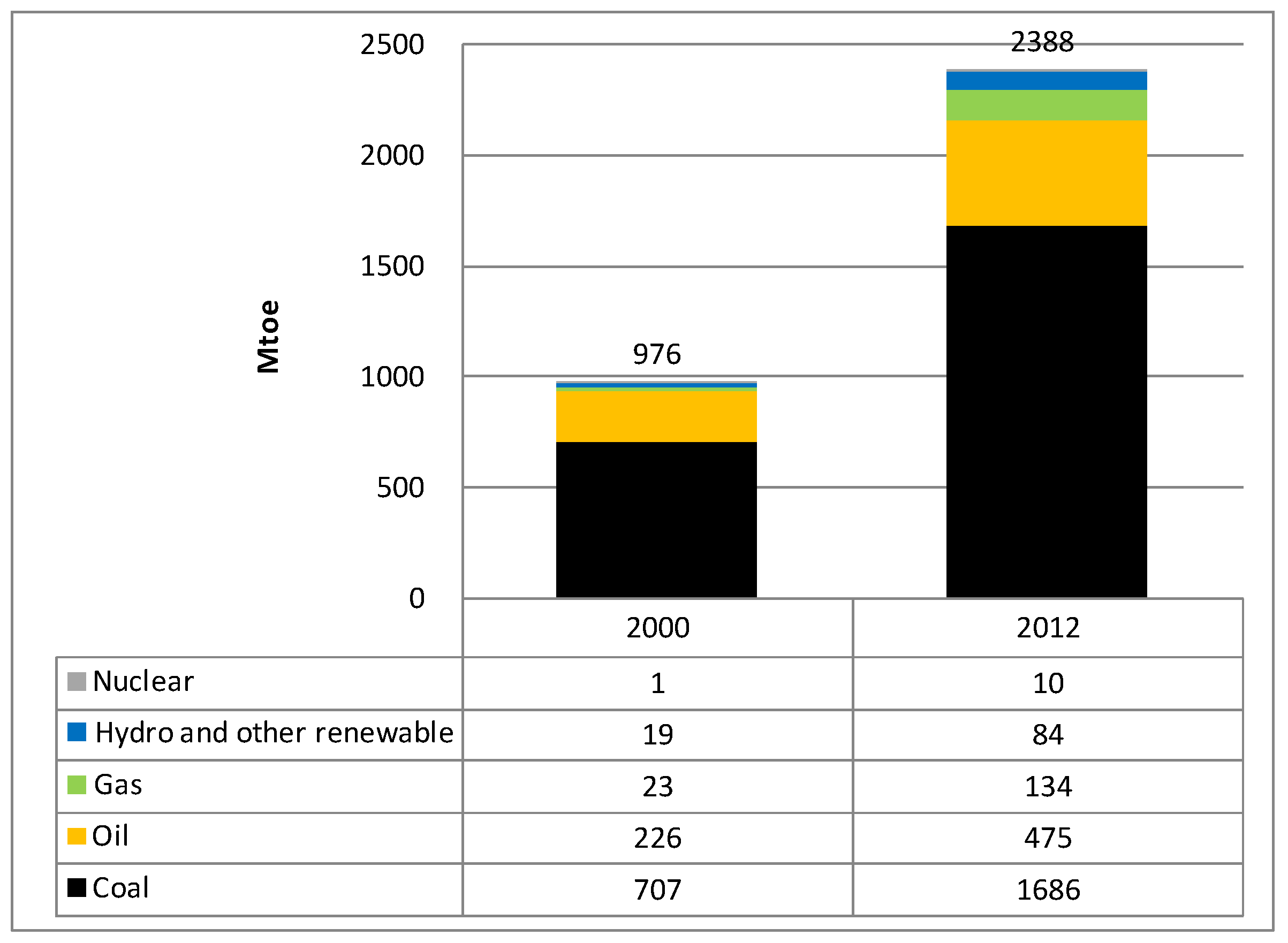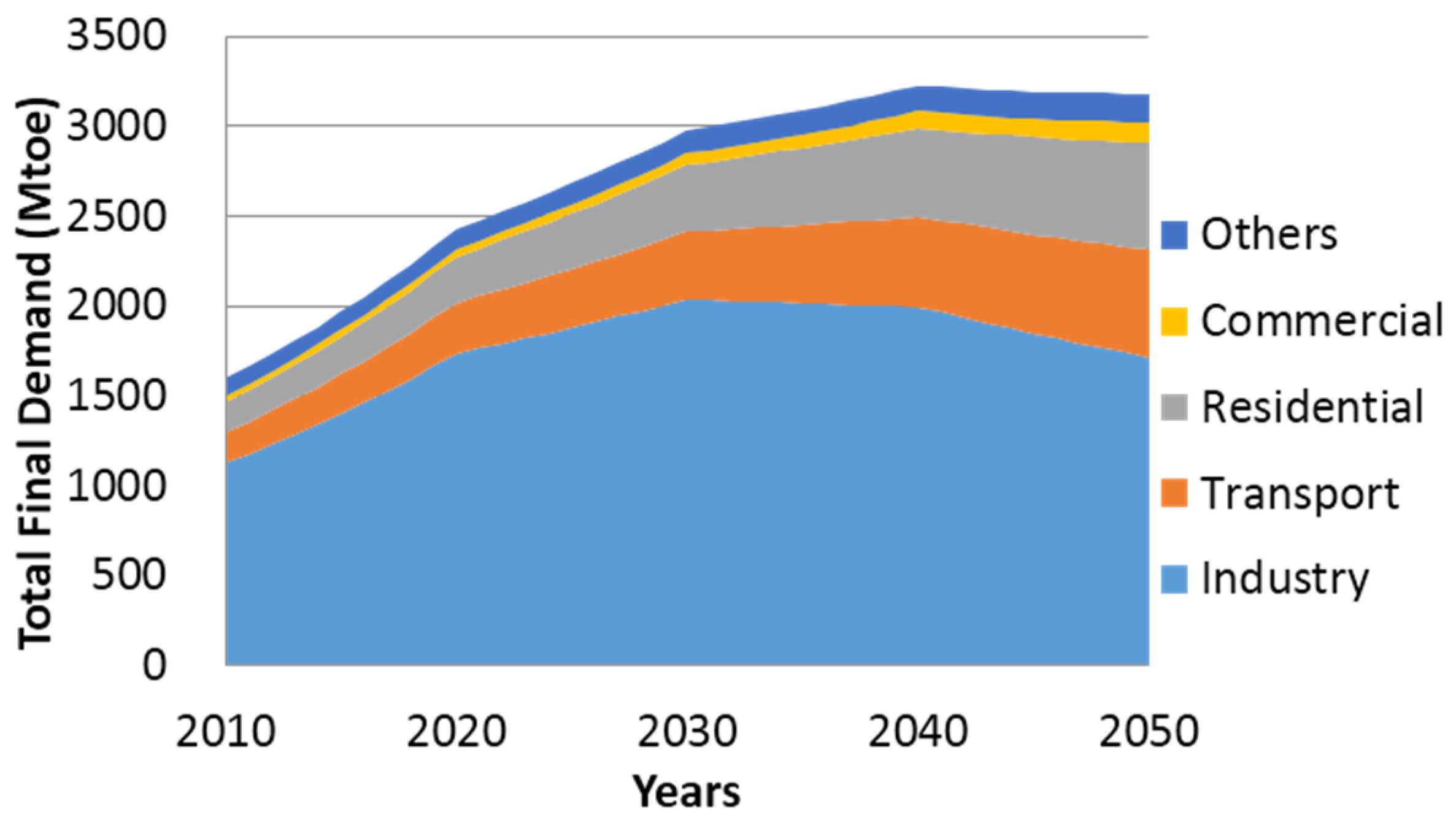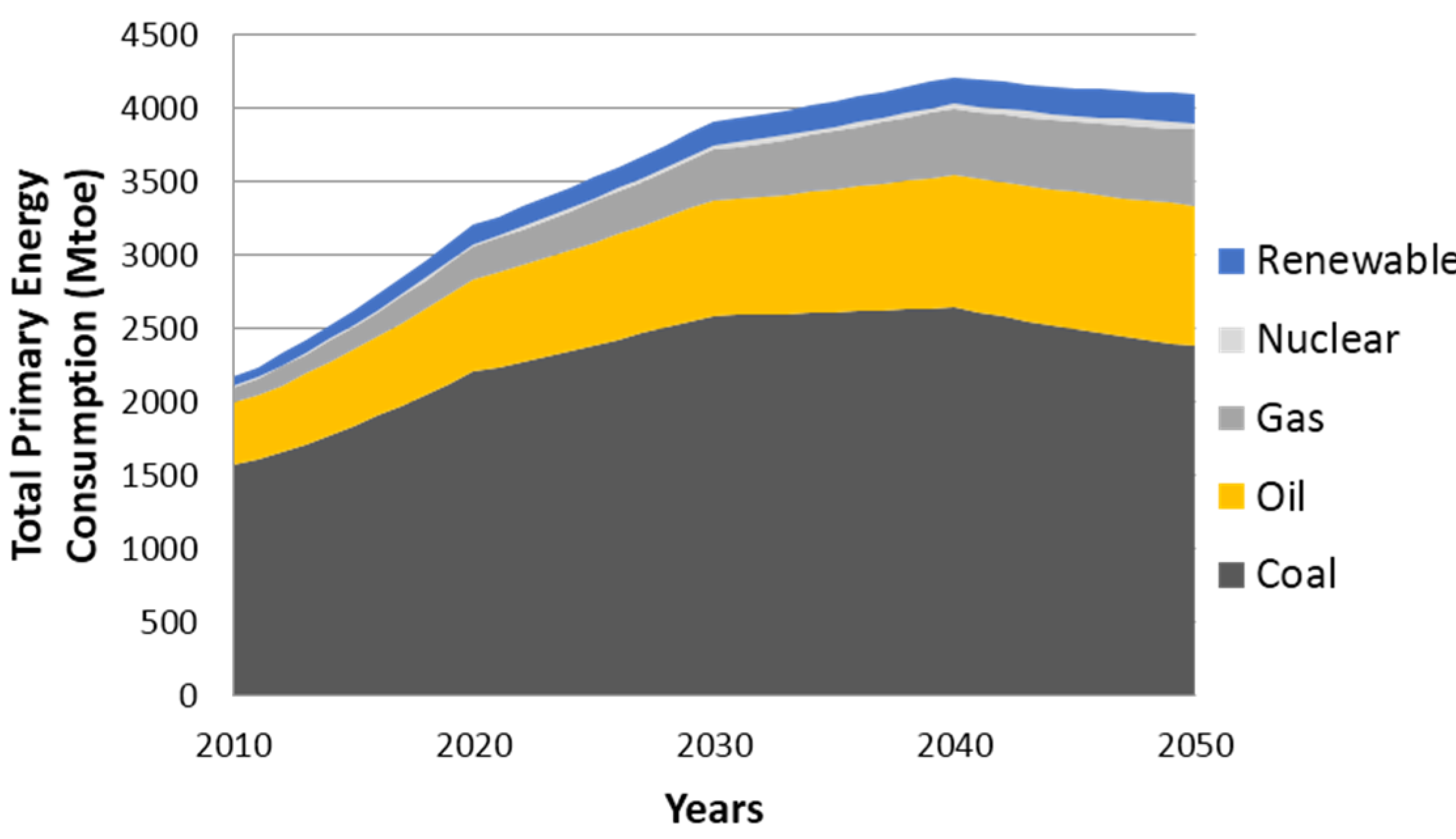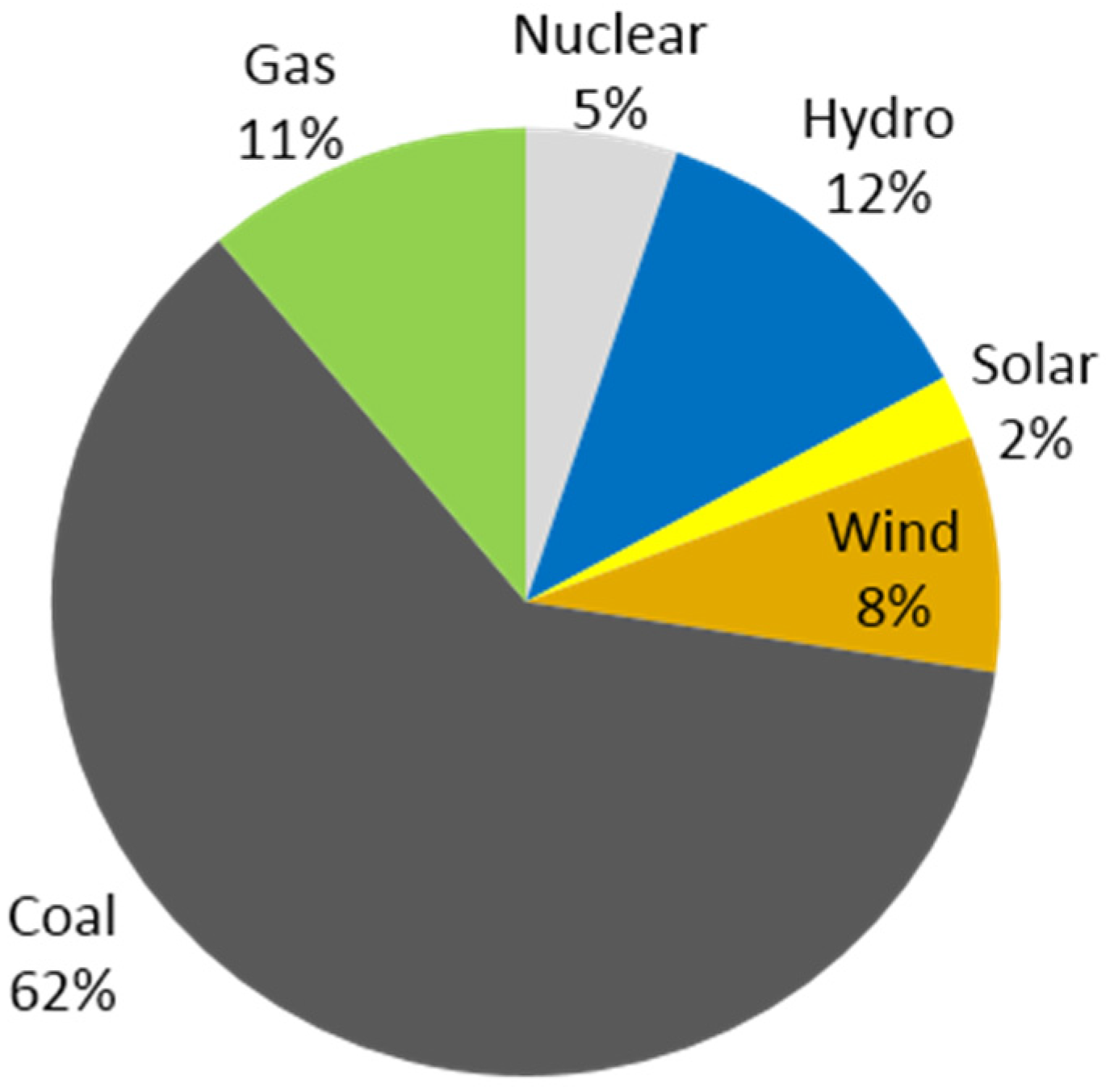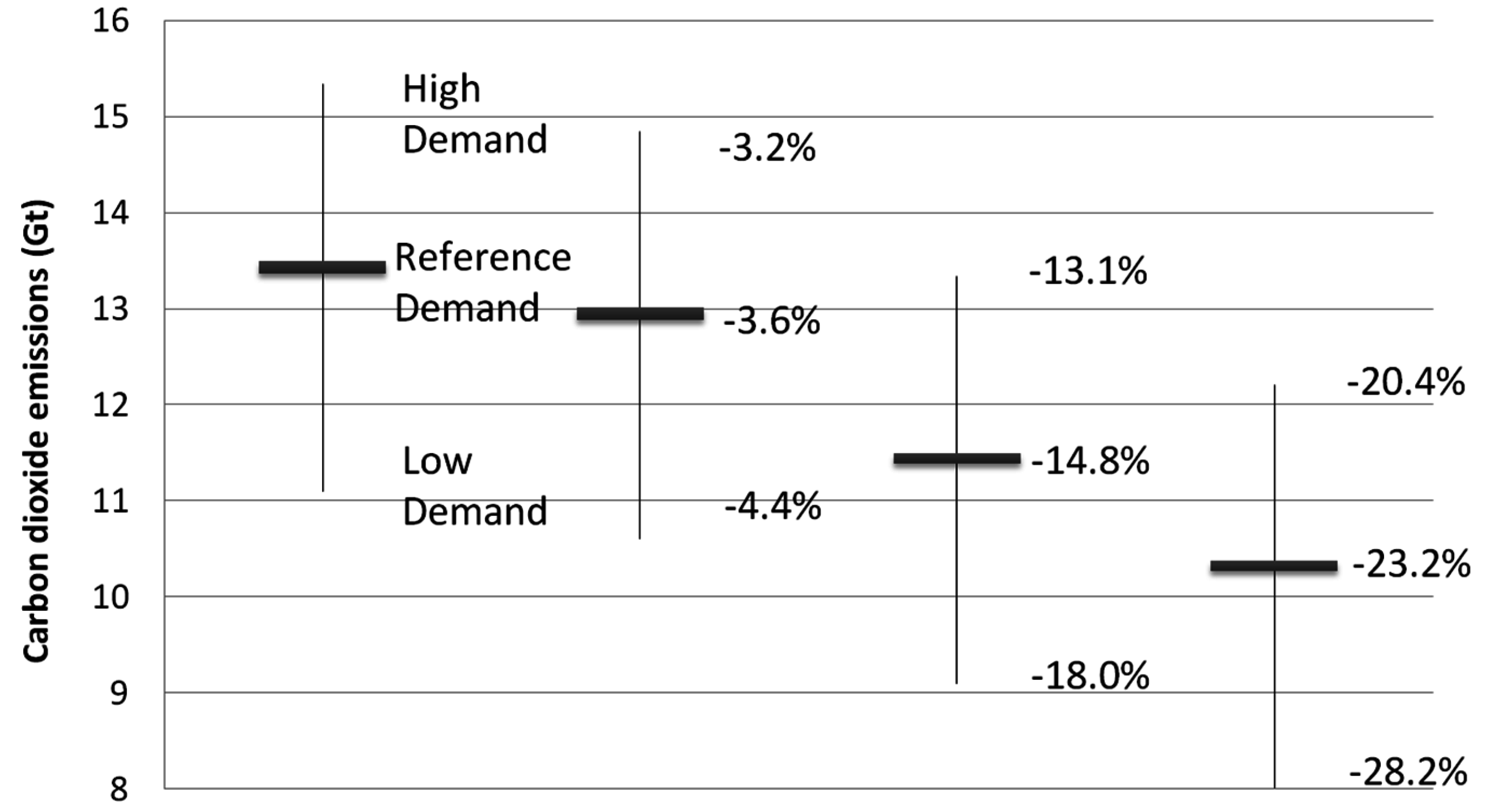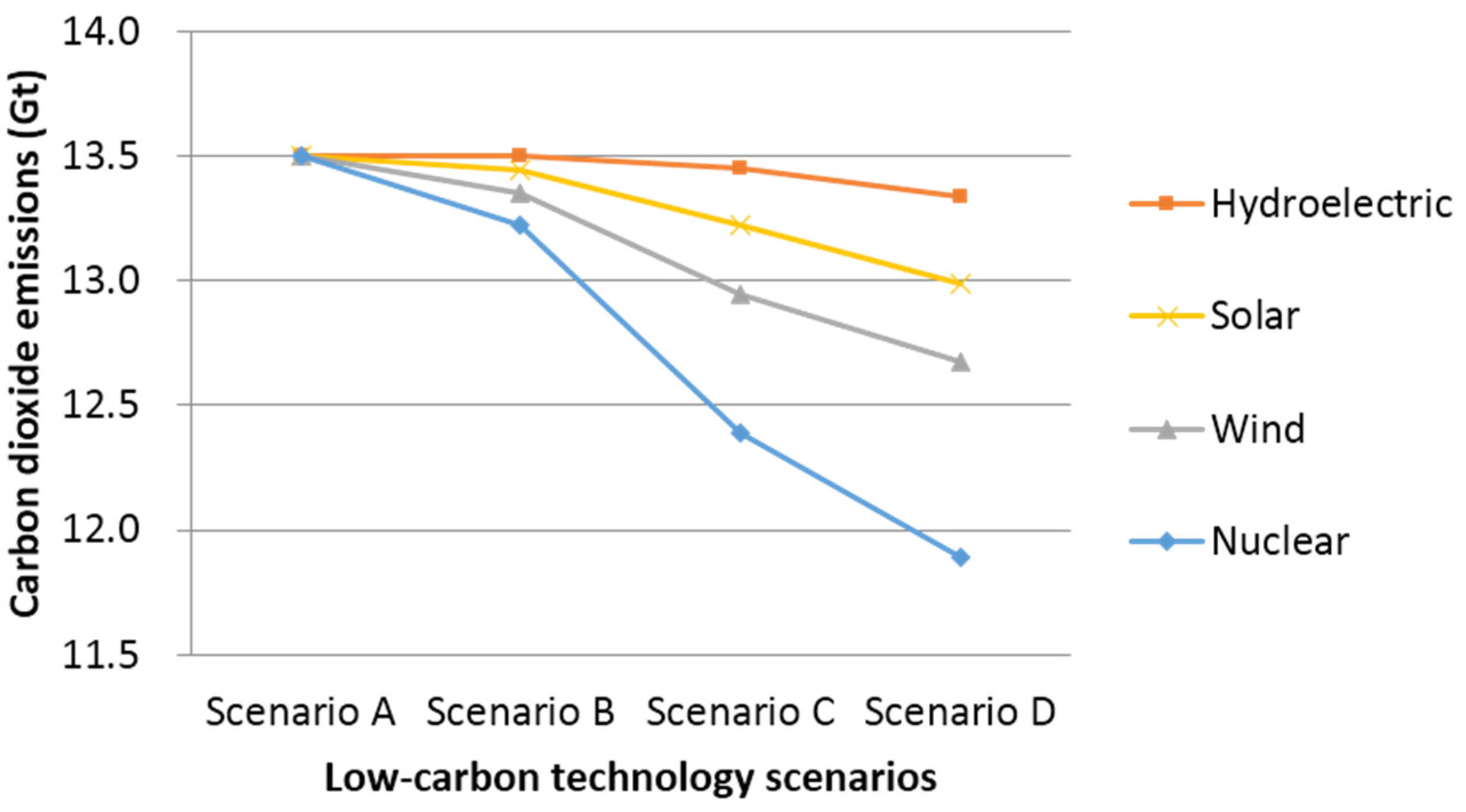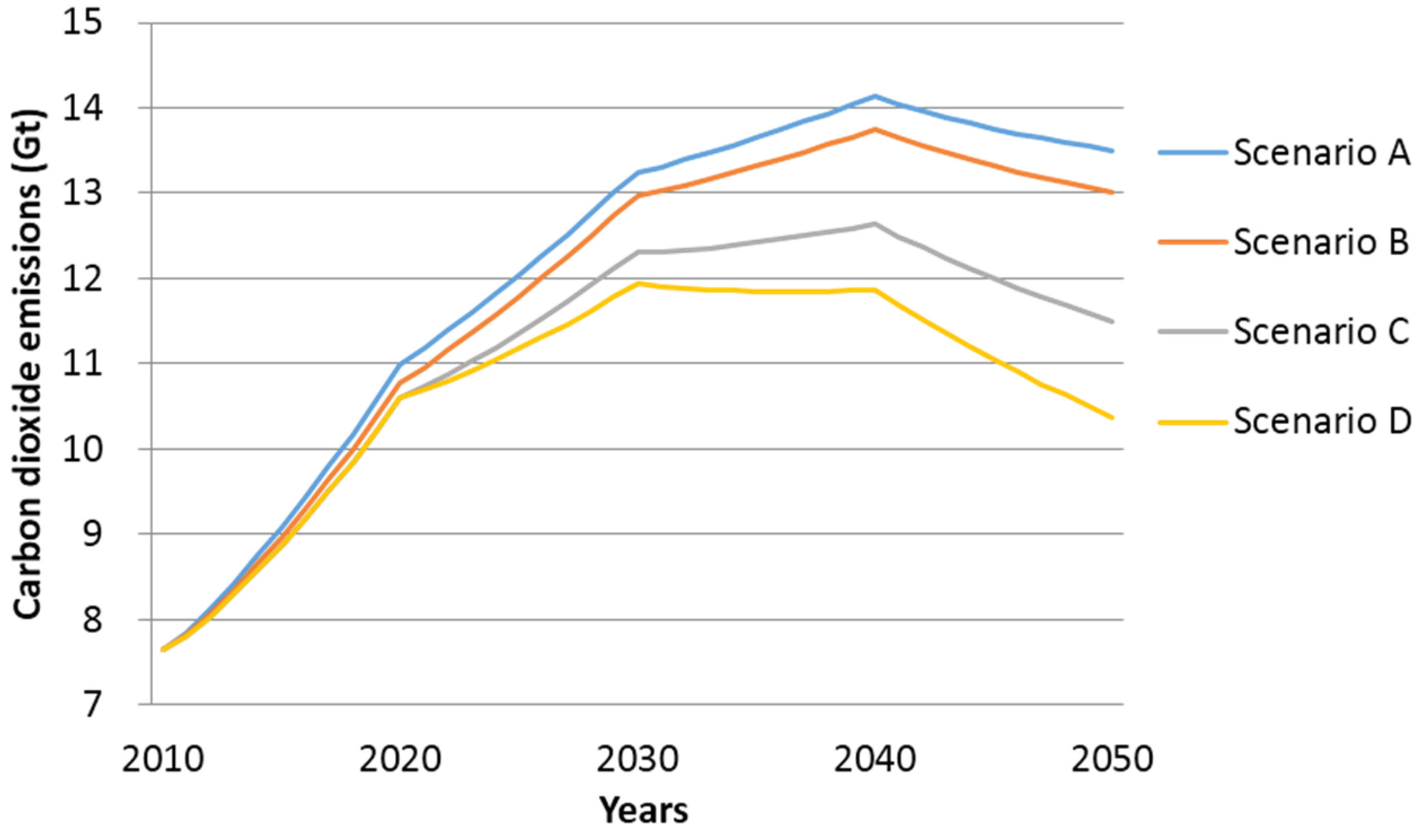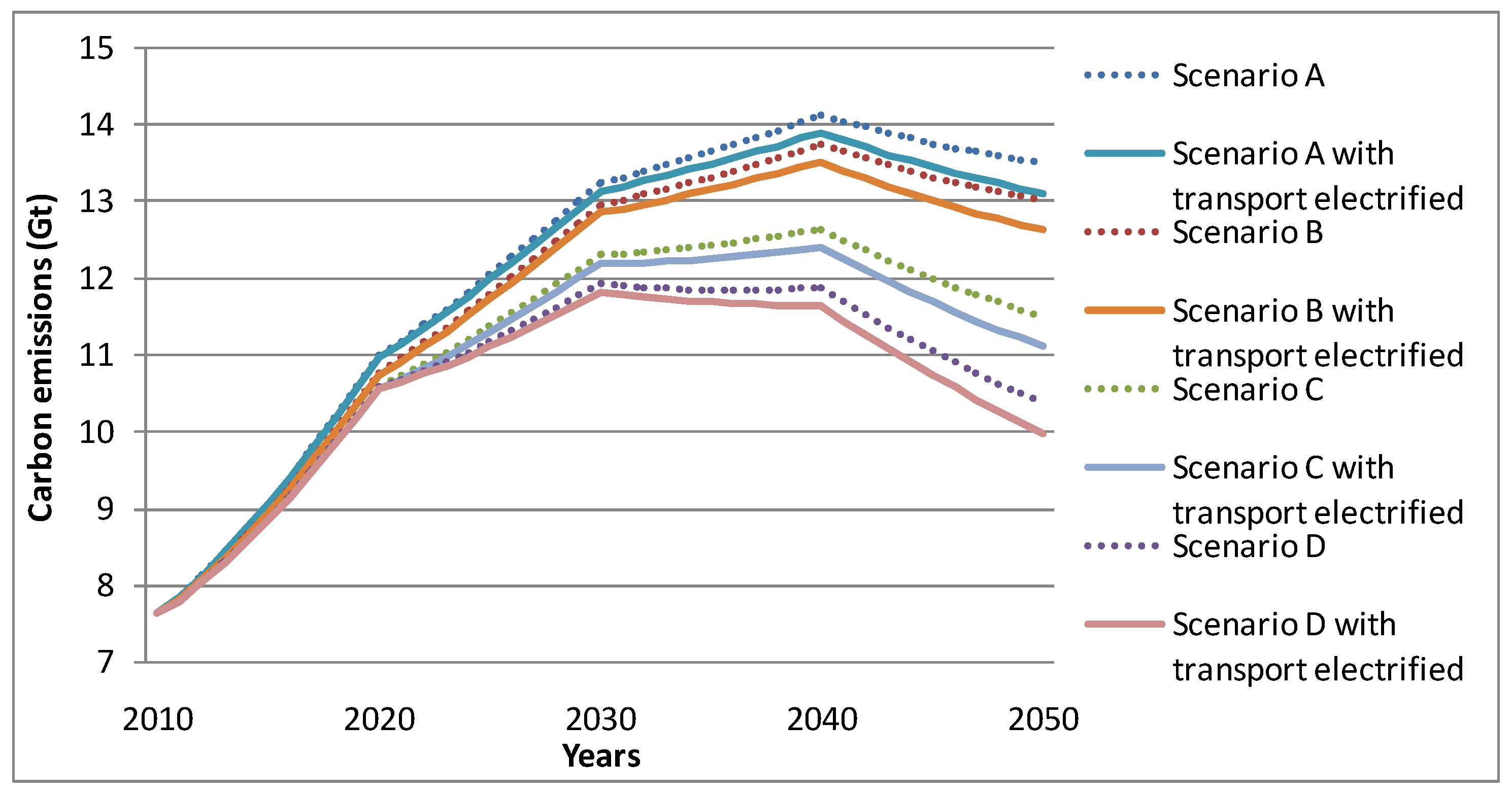1. Introduction
China’s primary energy consumption in the last decade has been increasing at a tremendous speed. From 2000 to 2012, total primary energy consumption in China increased by 121%, from 976 to 2388 million ton oil equivalent (Mtoe) [
1]. Consumption of coal, oil, gas, renewable energy and nuclear power increased by 145%, 139%, 110%, 485%, 330% and 559%, respectively.
Figure 1 illustrates that fossil fuel still dominates primary energy consumption and coal still remains the largest primary energy source. On the contrary, though increasing at a much faster rate, total amount of low-carbon power generation technologies only accounts for rather a small proportion.
Figure 1.
Energy consumption of China in 2012 [
1].
Figure 1.
Energy consumption of China in 2012 [
1].
Between 2000 and 2012, world carbon dioxide emissions from energy consumption increased from 24,150 million metric tons to 32,723 million metric tons [
2]. China accounted for more than 26% of the global carbon emissions in 2012 and is now the largest carbon dioxide emitter in the world. Given that China is predicted to maintain high economic growth rates [
3], total energy consumption and energy-related greenhouse gas emissions are expected to increase in a similar manner. Recently, a national plan was released committing to reduce carbon dioxide emissions per unit of GDP by 40 to 45 percent by 2020 from the 2005 levels and reach carbon emissions peaking by around 2030 [
4]. In order to achieve such goals, the plan set targets to boost the deployment of clean energy in China by 2020. Thus, it is worth analyzing possible pathways for China to reduce its emissions and alter its carbon emissions trends in the future as part of the global efforts to deal with the climate change issue.
Many international agencies have published their projection to future energy trends of China. International Energy Agency (IEA)’s World Energy Outlook 2012 (WEO 2012) [
5] gave three scenarios for future energy development: New Policies, Current Policies and 450 Scenarios. These scenarios considered a combination of various technical and political issues and generate future perspectives. The U.S. Energy Information Administration (EIA)’s International Energy Outlook 2013 [
6] projected several scenarios considering different economic perspectives and oil prices. Similarly, other institutions also published reports such as 2050 China Energy and CO
2 Emissions Report [
7], China’s Green Revolution: Prioritizing technologies to achieve energy and environmental sustainability [
8] and China Energy Medium and Long-term (2030, 2050) Development Strategy Research [
9]. Most of these reports extrapolated future energy demand trends in scenarios linearly depending on economic performances [
10]. In addition, they emphasized the importance of low-carbon technologies including nuclear energy, wind and solar, and indicated strong growth. However, these reports did not demonstrate how these technologies would be deployed considering historical experiences and practicality, as well as how these deployment pathways would alter carbon dioxide emissions trends in the long term. Thus, it is worth analyzing the contributions of different low-carbon technologies deployment pathways to emissions reduction and peaking in the future in order to set goals as well as deploy in advance.
As noted in the Energy Technology Perspectives 2014 [
11], another option for greenhouse gas emissions reduction was to reduce direct consumption of fossil fuel products at end use, for instance, natural gas, gasoline, diesel, whilst shifting to more use of electricity with an assumption that its greenhouse gas emissions coefficient would drop continuously as a result of structural change in the power generation sector. In the book
Sustainable Energy Without the Hot Air [
12], the author stated that electrifying transport and using heat pumps instead of burning gas would become effective approaches to reduce carbon emissions in the UK as long as the electricity is from a clean source. These studies indicated the potential of electrifying energy demand at end-use sectors in emissions reduction in the future.
The demand trends of end-use sectors have been extensively studied in order to achieve energy savings and carbon dioxide emissions mitigation. In most studies that focus on energy savings in demand sectors, such as industry and transport [
13,
14], energy supply side got relatively less attention, on which the mix of electricity sources could change carbon emissions substantially. Zhou
et al. [
15] developed the Lawrence Berkeley National Laboratory (LBNL) China End-Use Energy Model to analyze future energy demand and carbon emissions trends in China. This bottom-up model illustrated explicit energy saving methods at end-use sectors and constructed two scenarios: Continued Improvement Scenario (CIS) and Accelerated Improvement Scenario (AIS). The results indicated that carbon emissions would reach 10 Gt in the CIS and 7 Gt in the AIS by 2050 (both scenarios are without Carbon Capture and Storage (CCS)), whilst emissions peaking would be around 2030 in the CIS and 2025 in the AIS. However, the work did not consider much on the power supply side, for instance, it gave assumptions for overall efficiency and capacity by 2050 without explaining reasons and practicality. In addition, the scenarios in this work combined improvement at end-use sectors and decarbonization in power supply, thus it cannot reflect the contributions of low-carbon technologies to carbon emissions reduction and peaking. Gambhir
et al. [
16] established a hybrid model and gave three scenarios: Hypothetical Counterfactual Baseline (HCB), Efficiency and Mix. Energy demand in each scenario in this study was built based on a bottom-up model, and energy supply was optimized based on costs, technical parameters and policy assumptions. Compared with a bottom-up model for supply, this approach was an effective way for future capacity planning, rather than studying the potential of low-carbon technologies in carbon emissions reduction and emissions peaking. In addition, this study included CCS in the Mix scenario. However, due to the lack of commercialized CCS experiences worldwide and governmental policies nationwide, tremendous challenges and uncertainties are on the way to large deployment of CCS by 2050 [
17]. Thus, it would be quite a great uncertainty to include CCS technology in models.
In order to study the roles of clean energy and electrification to energy-related carbon dioxide emissions mitigation and peaking, this paper aims at building a transparent bottom-up model giving insights into two issues. The first one is how China is likely to deploy low-carbon energy technologies based on policies, practicality and international experiences, and how these deployment would alter carbon dioxide emissions trends up to 2050. The second one is to study the effects of electrifying demand sectors on emissions reduction and peaking under different clean energy deployment pathways. The remaining of this paper is organized as follows.
Section 2 demonstrates the principles behind the bottom-up model used to analyze the energy system and sets scenarios for future demand trends and supply pathways in China concerning different levels of electrification for demand sectors and the potential of low-carbon technologies in energy supply.
Section 3 shows the effects of low-carbon technologies and electrification on carbon emissions reduction and peaking based on combinations of proposed scenarios.
Section 4 concludes the results and gives main findings.
Section 5 provides policy implications for the deployment of low-carbon technologies and electrification in the future.
4. Conclusions
China has experienced rapid economic growth and it is expected that China will have optimistic economic performances through to 2050 along with increasing energy consumption as well as attendant growth in the level of carbon dioxide emissions.
A bottom-up model is built in this paper to estimate how low-carbon technologies and electrification would affect future energy-related carbon dioxide emissions trends. Results show that by deploying low-carbon technologies on a large scale (360 GW for nuclear, 450 GW for hydroelectric power, 950 GW for wind and 700 GW for solar), carbon emissions can be reduced by 20 to 28 percent by 2050 compared with the Reference Scenario (70 GW for nuclear, 379 GW for hydroelectric power, 400 GW for wind and 170 GW for solar) under different economic growth trends. More importantly, this could bring carbon emission peaking forward from 2040 to 2030. In terms of potential carbon dioxide emissions reduction for different low-carbon technologies, nuclear power could achieve the highest emissions reduction owing to its foreseeable rapid development, 290 GW addition compared with the “business as usual” case. By contrast, although wind and solar would have large capacity addition, their contributions to carbon emissions reduction are less notable than nuclear. This is mainly because of their low annual operating hours compared with nuclear energy.
In addition, the effect of electrification is studied. It turns out that electrifying industry, residential and commercial sectors would increase emissions but electrifying transport would reduce emissions with the reference demand trend. Moreover, the increase in emissions by electrifying industry, residential and commercial sectors and the reduction in emissions by electrifying transport would become greater if the deployment of low-carbon technologies accelerates. However, these changes accounts for a small share compared with the emissions in the Reference Scenario and are less significant compared with the emissions reduction that could be achieved by deploying low-carbon technologies. Last but not least, electrifying transport would accelerate the advent of carbon emission peaking.
5. Policy Implications
In terms of future development of low-carbon technologies, their contributions to carbon emissions reduction are significant. Nuclear power should be deployed with priority due to its large potential capacity addition and high availability. However, deployment speed for low-carbon technologies in Scenario D requires higher construction practicality than the current achieved. These indicate the importance of the government to further push the limit of construction practicality, especially for nuclear, by implementing encouraging policies in order to achieve lower emissions through clean energy supply.
With respect to electrification, the results imply that electrifying industry, residential and commercial sectors will not substantially reduce emissions as long as coal is the major fuel for electricity generation. Thus, it is necessary to decarbonize power generation before electrifying these demand sectors. On the other hand, electrifying transport will not only reduce carbon dioxide emissions but also bring carbon peaking forward. Policies should promote the development of electric vehicles to reduce carbon emissions and this might be considered for the purpose of reaching carbon emission peak by 2030 as well.
